2020
January 10 - February 22: Gerard Pas: Broken Body
Broken Body
Gerard Pas
Curated by James Patten
January 10 - February 22, 2020
Opening reception: Friday January 10, 7:00–9:00 p.m.
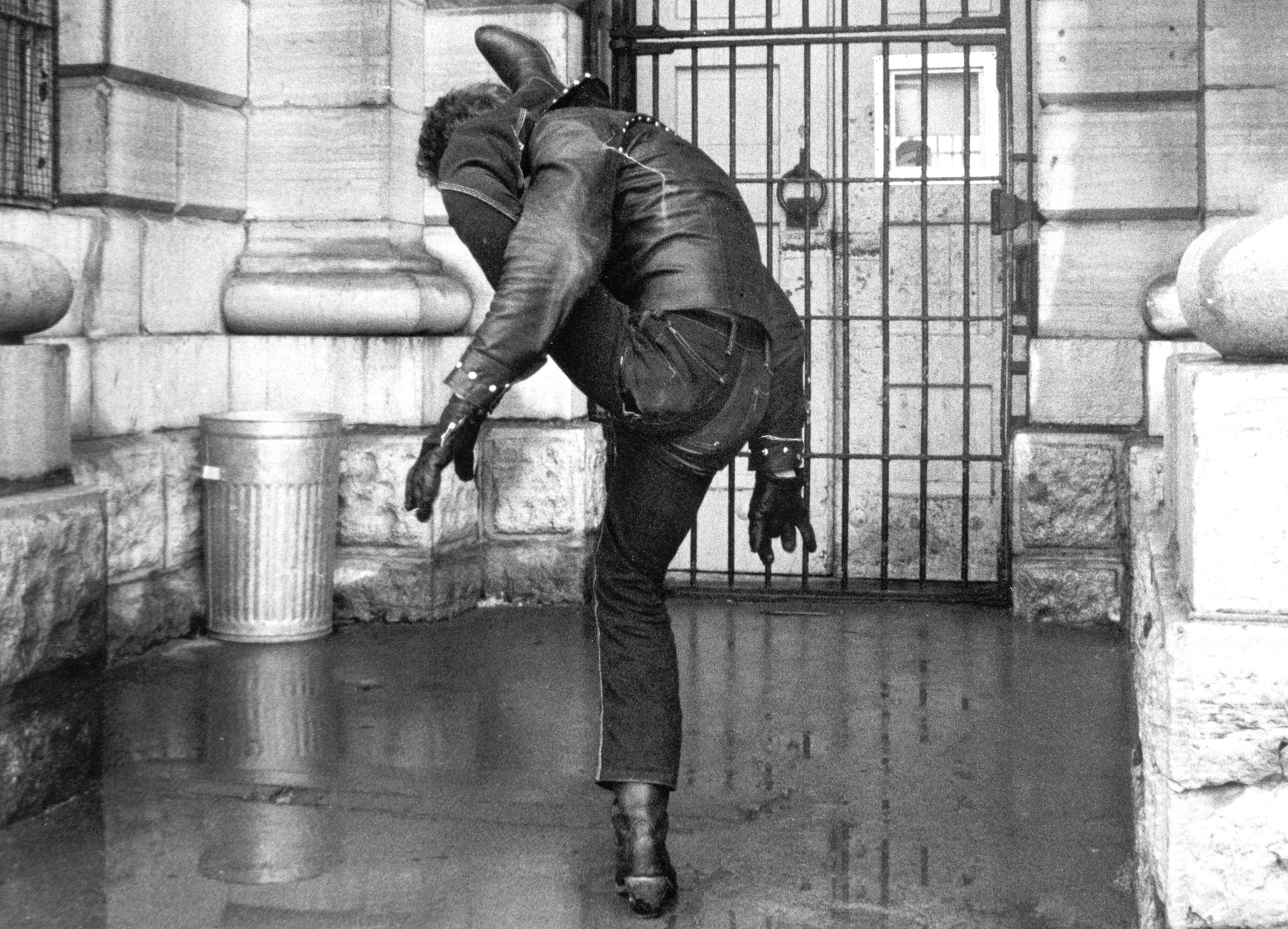
Gerard Pas, Un Autre Faux Pas (detail), 1978. Performance documentation courtesy of Tobey Anderson.
London artist Gerard Pas has been a pioneer of disability arts in Canada since the 1970s. He is among the first generation of international artists who expressed their identities as disabled people in order to challenge prevailing attitudes and stereotypes.
Pas’ self-reflective performances, photographs, sculptures, and paintings are informed by the radical political activism of the 1960s and motivated by the frustration of being culturally and socially marginalized because of his atrophied leg, which was the result of having polio as a child. Pas fought back with profound, moving works informed by the conflicting traditions of Modernism and Realism particularly in his native Holland. At the same time, he realized that both aesthetic movements were dependent on idealization, rationalism, and depersonalization. Modernism’s seductive claim to “pure form”, as represented by Piet Mondrian and Gerrit Rietveld, whose Red and Blue Chair, 1918–1923, was the basis of Pas’ bathetic wheeled version, was in striking contrast to his own more complex and nuanced lived experience.
The angst and cynicism of contemporary punk aesthetics, combined with Pas’ experience with disability, was a potent entanglement that produced an entirely new way of enacting disability through raw, energetic performance. His art practice embodied the intersections of disability, migration, class and the negation of social systems that were at the core of punk aesthetics. Standing in front of the Kingston Penitentiary, his left leg behind his head, he lit a cigarette in defiance and contempt of the penal system’s rule-based authority and emphasis on eroding individualism by controlling and standardizing the body and everyday life.
Pas enacts a Brechtian critique of oppression and the strictures of modernist purity and formalism. His dialectical approach reveals the contradictions inherent in conventional representations of idealized bodies in a harmonious, utopian world. Even within the seemingly defiant world of performance art, most artists still perpetuated the idealized beauty standards of the day. Both funny and confrontational, Pas’ performances deftly dismantled pre-conceived ideas about how he was supposed to interact with the world and how the world was going to react to him. This in turn informed his work in other media in which he carefully breaks social and aesthetic conventions to uncover hidden realities and awkward truths.
Related exhibition programming:
Artist-led exhibition tour with Gerard Pas
Thursday, February 13 at 2:00 p.m.
McIntosh Gallery
Curator-led exhibition tour with James Patten
Thursday, February 20 at 12:30 p.m.
McIntosh Gallery
For more information about McIntosh Gallery and this exhibition, contact Abby Vincent, Communications and Outreach Coordinator, avince5@uwo.ca, 519.661.2111 ext. 87576.
March 6 - April 9: Kelly Greene: Accountability
Accountability
Kelly Greene
Curated by Helen Gregory
March 6 - April 9, 2020
Opening reception: Friday, March 6 at 7:00 p.m.
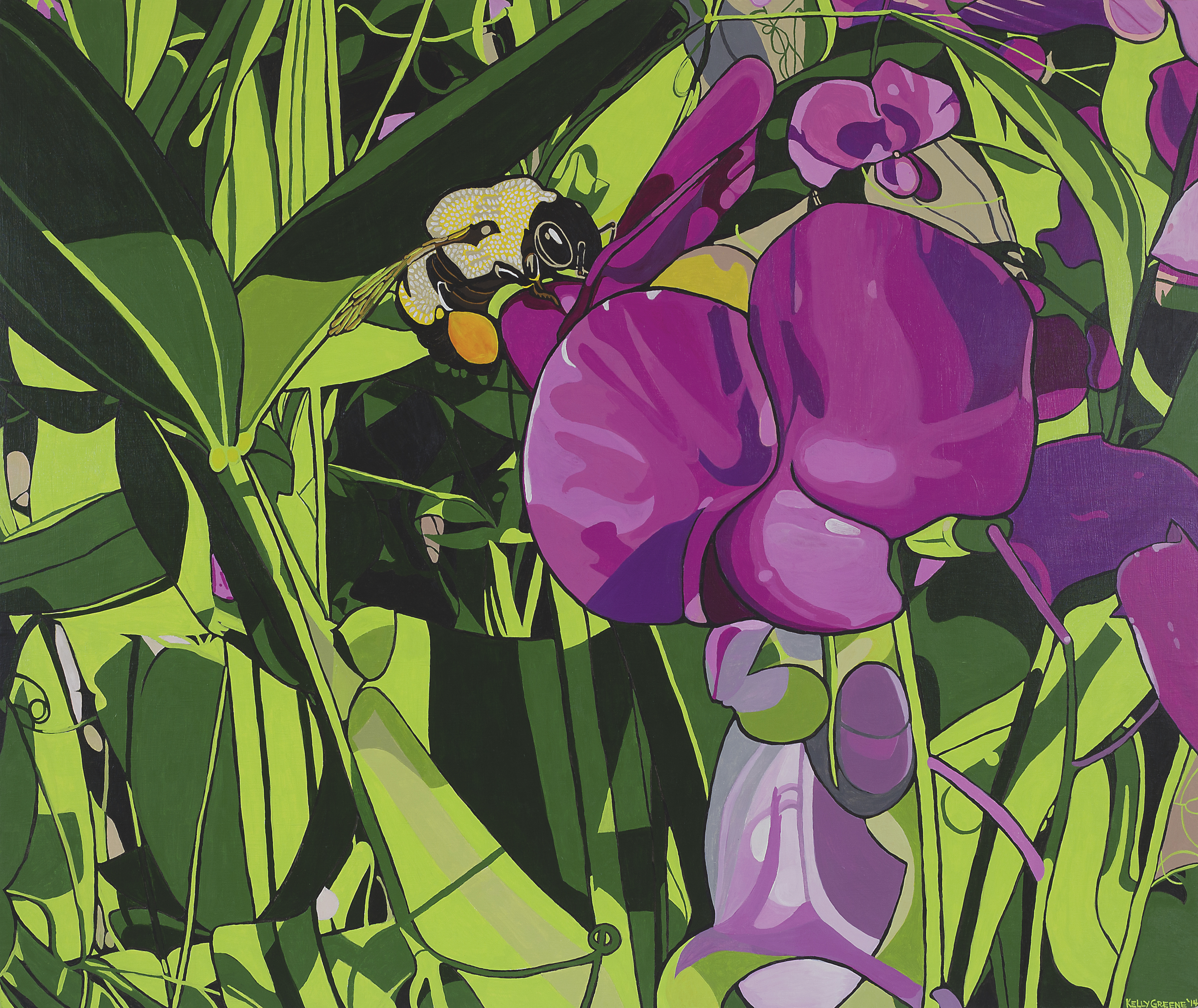
Kelly Greene, Attempting to Correct Disorder 2014, acrylic on panel. Courtesy of the Woodland Cultural Centre.
McIntosh Gallery is pleased to present Accountability, an exhibition of work by London, Ontario-based artist, Kelly Greene. Greene is a multi-media artist who works in painting, sculpture, installation, and photography. A Mohawk member of the Six Nations of the Grand River in Ohsweken, Ontario, Greene focuses on topics that include environmental concerns as well as the impact that colonization has had on Canada's First People. Although she wasn’t raised within her Indigenous heritage, Greene has spent much of her adult life learning about her Haudenosaunee identity.
As she works towards a deeper understanding of her own culture, Greene investigates the multiple ways in which the notion of accountability occurs across key issues affecting Indigenous people. As a nation with its roots in colonization by European settlers, Canada must remain accountable to the history of injustices by honouring past treaties and recognizing the importance of restitution in the healing process. Indigenous people must remain accountable to themselves by taking on the responsibility for keeping their languages and traditions alive and, by passing them on to younger generations, mitigating further loss of vital knowledge and culture. And we must all take on the responsibility of caring for our Earth that sustains us. In her work, Greene makes specific references to the Haldimand Treaty granted to the people of Six Nations, as well as the Mohawk Institute Residential School, or “Mush Hole”, which her Grandmother attended in the 1920s. Greene’s ongoing concern towards increasingly pressing environmental issues has inspired work that represents Earth as Mother, honouring Haudenosaunee belief.
Greene began her visual art studies at the University of New Mexico and went on to earn a BFA from Western University. Her work has been exhibited at the Woodland Cultural Centre (Brantford, Ontario), Saw Gallery (Ottawa, Ontario), Walter Phillips Gallery (Banff, Alberta), Thunder Bay Art Gallery (Thunder Bay, Ontario), Iroquois Indian Museum (Howes Cave, New York), Gary Farmer Gallery (Santa Fe, New Mexico), and others. Greene has been the recipient of grants from the Canada Council for the Arts and the Ontario Arts Council.
McIntosh Gallery acknowledges with gratitude the financial support of the McIntosh Gallery Art and Travel Committee that made this exhibition possible.
For more information about McIntosh Gallery and this exhibition, contact Abby Vincent, Communications and Outreach Coordinator, avince5@uwo.ca, 519.661.2111 ext. 87576.
March 6 - June 13: Johannes Zits: Listening to Trees
Listening to Trees
Johannes Zits
Curated by James Patten
March 6 - June 13, 2020
Opening reception: Friday, March 6 at 7:00 p.m.
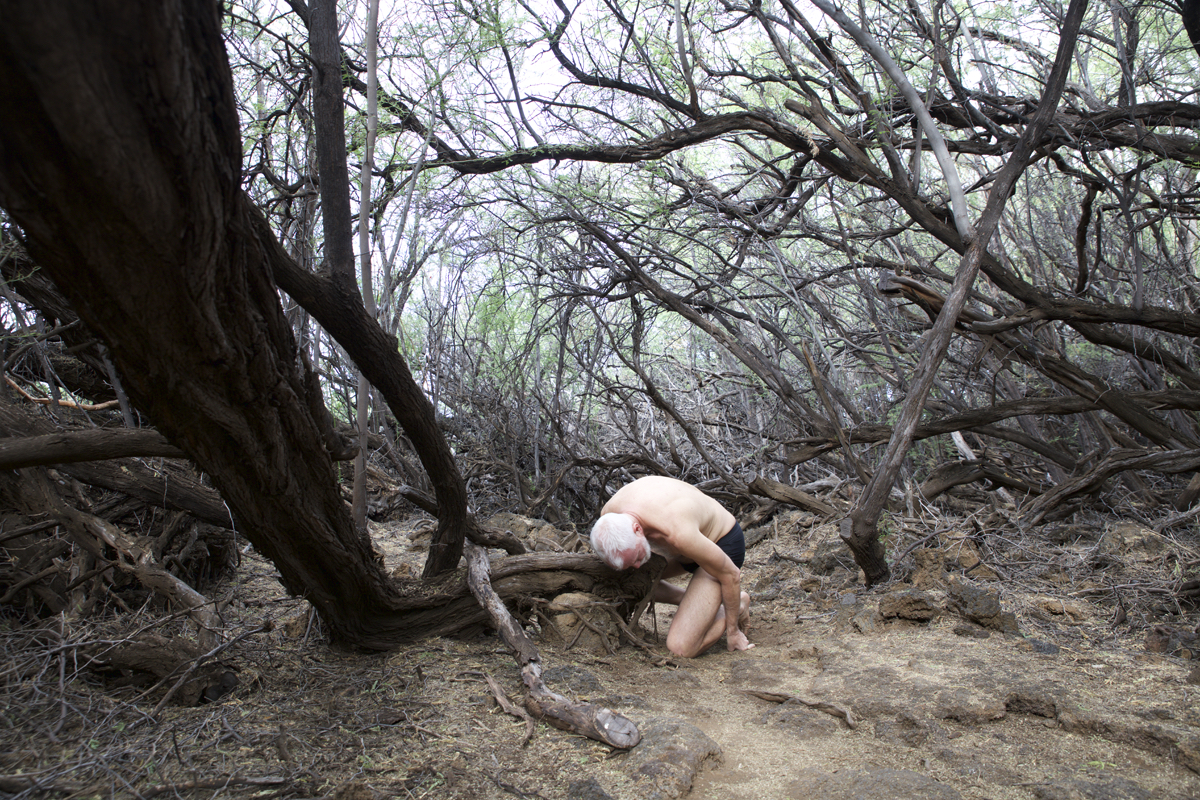
Johannes Zits, Up and Over a Stone, Kiawe Tree 2018, performance, Kona, Big Island, Hawaii, photography: Ed Pien. Courtesy of the artist.
Many of us, especially in Canada, would claim a special relationship with trees and forests. But if we were asked to define that relationship, or to describe our interactions with trees, we might come up short on answers. For the past ten years, Toronto performance artist Johannes Zits has been working with trees around the world. From Cambodia to Cuba, the trees he chooses tend to have unique historical or cultural value within communities. Some have borne witness to horrific human tragedies. Others mark the gradual development of communities as a gathering place or landmark.
Using nonverbal actions, he approaches nature as a body that is alive, vulnerable, and socially contextualized. Instead of making nature a passive backdrop in front of which human history unfolds, his encounters with trees are reflective and empathetic. Aligned with panpsychism, a philosophical world view in which all matter has consciousness, Zits' practice shares an affinity with cultures in which humanity is seen as continuous with nature. To this end, he often collaborates with local communities to enhance his performances and interactions with trees.
In London, Johannes Zits will be in residence at McIntosh Gallery from March until June. While here, he will be investigating the remnants of an avenue of 160-year-old black walnut trees that, at one time, lined the drive from Western Road to the old Kingsmill house that once stood near Middlesex College. He will also be researching and interacting with an ancient white oak, possibly 600 years old and called the meeting tree, that is said to have links to the Underground Railroad. His exhibition at the gallery will be completely transformed during the residency by the research he does in London.
A series of talks, workshops and walking tours with Johannes and other guests will be offered so that everyone can participate and learn more meaningful ways to experience nature and listen to trees.
About the artist:
Since graduating with a BFA from York University in 1984, Johannes Zits has presented work across Canada as well as internationally. In 2013, Zits performed at the 8th Encuentro, Sao Paulo, Brazil and showed videos at Le festival international du film sur l’art, Montreal. In 2014, he presented variations on the performance Island at M:ST Festival, Calgary, Yuz Museum, Shanghai and at Meta 2014, Chongqing, China.
Johannes Zits has achieved global recognition for his performances and videos about the body and how it interacts with social and natural environments. His approach to nature is collaborative. He treats it as another sentient body replete with vulnerabilities, movements, desires and dynamic affective relationships. His collaborative approach is evident in the videos Elemental Gestures, in which he empathizes with driftwood, and Embodying Nature (2010), which combines a two person performance in a Chinese bamboo forest with group actions in a gallery setting.
About the residency:
Johannes Zits will be in residence at McIntosh Gallery from March until June. While here, he will be investigating the remnants of an avenue of 160-year-old black walnut trees on campus. In 1916, the University of Western Ontario purchased the 150 acre Bellevue Farm, owned by the Kingsmill family, for its new campus. The Kingsmill house stood in the wooded area next to Middlesex College. Access was from Western Road along a serpentine lane flanked by black walnut trees. A double row of these trees in front of Middlesex College still marks the end of the driveway. A few trees also persist near McIntosh Gallery. In 2002, Netta Kingsmill Brandon (Arts, 1944) donated funds to plant a grove of seven black walnut trees near McIntosh Gallery to commemorate the gallery’s innovative artist in residence program.
According to Johannes Zits:
I would explore what happens when the pace of the walk is changed or the level at which we are observing what is around us. What is noticed on these walks will be applied to a recreation of the path of the old walnut trees that led to the site of the Kingsmill’s farm house. The goal here is to reconcile what is seen and to connect with what once was. The act of walking outside is about receiving or taking; the question is how that can be transferred into another realm or space. This leads to the question that maybe the active walking outside is a performative act in of itself and could be the performance.
Zits will also be researching and interacting with an ancient white oak, possibly 600 years old and called the meeting tree, that is said to have links to the Underground Railroad.
His exhibition at the gallery, which includes photographs of his previous interactions with trees in many countries and wooden performance props, will be completely transformed during the residency based on the research he does in London. A series of talks, workshops and walking tours with Johannes and other guests will be offered so that everyone can participate and learn more meaningful ways to experience nature and listen to trees.
Using trees and wooden objects, Zits and program participants will develop performances that consider the historical and cultural significance of trees and wooden objects found in natural and in constructed environments. The workshops focus on receiving information and translating it through body movements. Participants will be acquainted with the concepts of dynamic listening, deep hanging out, and forest bathing. They will develop strategies for using their bodies to interpret and reconnect to nature based on non-western knowledge systems.
Related Programming:
Artist Talk
Thursday March 12, from 4:00 p.m. to 5:00 p.m.
Performative Action Workshop
Saturday March 21, from noon to 3:00 p.m.
Postponed indefinitely
Maximum eight participants, please contact Abby Vincent to reserve your place at mcintoshgallery@uwo.ca.
Walking Tour with Michael Lunau, Manager of Landscape Services, Western University
Thursday April 2, from noon to 1:00 p.m.
Postponed indefinitely
Walking Tour of the Sherwood Fox Arboretum
Thursday May 21, from noon until 1:00 p.m.
Postponed indefinitely
Excursion to the Meeting Tree at Westminster Ponds
Saturday May 23, from 1:00 p.m. to 4:00 p.m.
Postponed indefinitely
Space is limited, please contact Abby Vincent to reserve your place at mcintoshgallery@uwo.ca.
Anishinaabe Cosmology: Restoring spirit and land
Presentation by Mkomosé (Dr. Andrew Judge)
Postponed indefinitely
A meditation on remembering what it means to be a human–Indigenous knowledge for a changing climate
Presentation by Mkomosé (Dr. Andrew Judge)
Postponed indefinitely
Walking and Listening Workshop
Saturday May 30, from noon to 3:00 p.m.
Postponed indefinitely
Maximum eight participants, please contact Abby Vincent to reserve your place at mcintoshgallery@uwo.ca.
Outdoor Performance by Johannes Zits
Tuesday June 2, from 2:00 to 4:00 p.m.
Postponed indefinitely
The Opening of a Leaf
Ongoing through June 13
Participate in Zits' ongoing residency by photographing unfurling tree buds in your backyard, in a park or an alley nearby, or anywhere trees grow in your community.
July 10 - 24: Yas Nik Khoshgrudi: The Prototype for the Soul
The Prototype for the Soul
Yas Nik Khoshgrudi
July 10 – 24, 2020
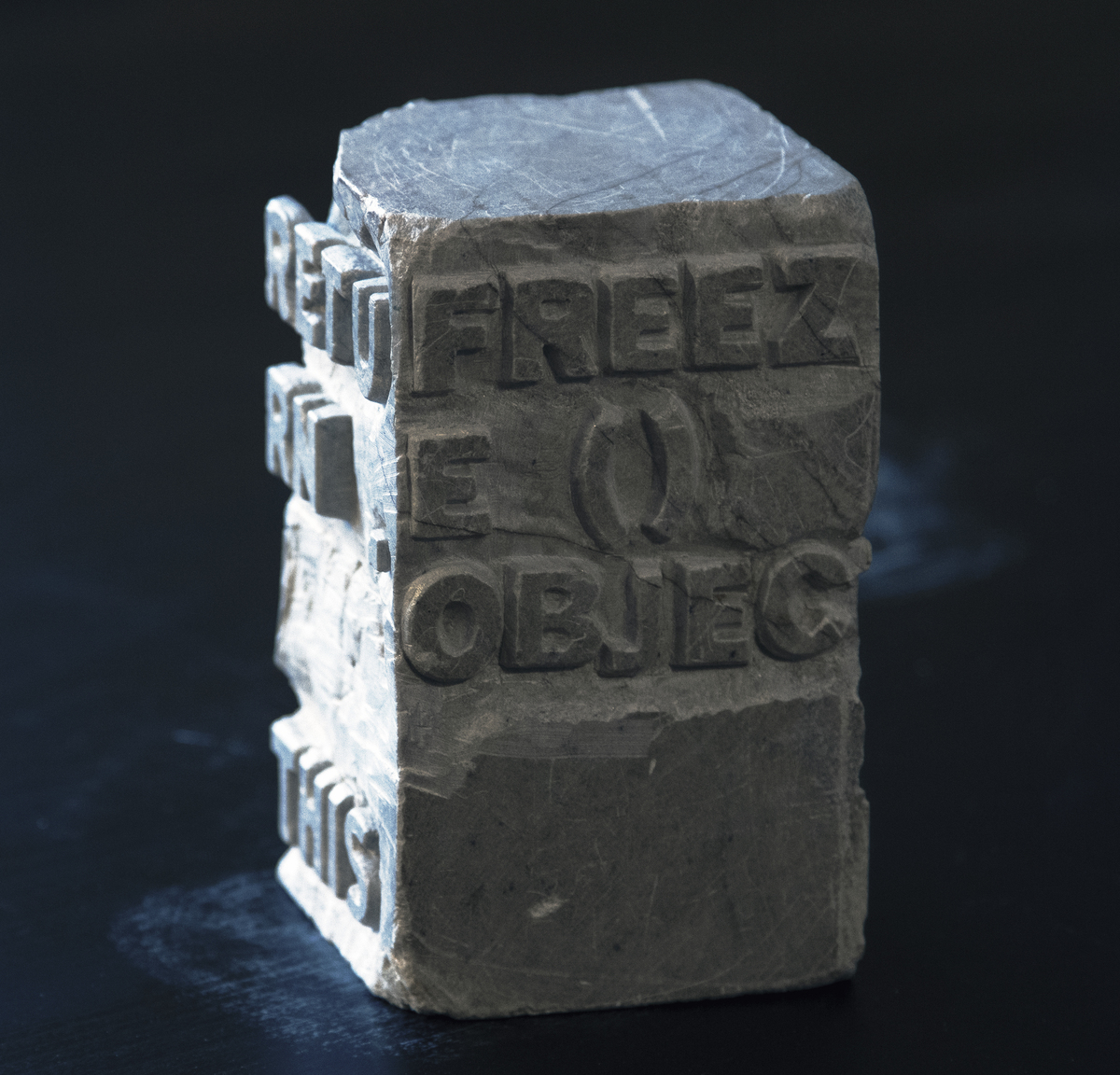
Yas Nik Khoshgrudi, For the Damaged Coda 2019, installation. Courtesy of the artist.
The Prototype for the Soul traces the relationship between traditional literary narrative texts and digital media. The concept of virtual reality as an interactive digital narrative alters conventional understanding of interactivity in reading. According to the artist, “reading integrates the reader's interaction as a vital part of the sign-production process by which we would be able to define them as a concept, and in the same sense as a piece of literature".
Khoshgrudi asserts that the scripts for the roles that we play are found within fantasies of the unconscious mind. According to Brian Massumi, “the dimension of proprioception lies midway between stimulus and response, in a region where unfolded tactile encounter meets externalizing response to the qualities gathered by all five senses. It performs a synthesis of those intersecting pathways in the medium of the flesh, thus opening to its own quasi corporeality”. The works in this exhibition alternate between physical objects and code, exploring the processes of translation and the manifestations of fantasy inherent in digital media interpretation.
The artist explores the relationship between digital and physically lived experiences as inseparable, examining the ways in which one affects the other in a parallel fashion. Her work focuses on self-awareness through digital experiences. She imagines a state in which lived experience comes from both a virtual space and real life. The primary concept is that the core of our psychic life takes place in a “virtual reality”, where each of us is a subject of imagination.
Yas Nik Khoshgrudi is a multidisciplinary artist based in Toronto. She completed her BFA (painting) at Tehran University of Art and is currently an MFA candidate in the Department of Visual Arts, Western University.
August 7 - September 4: Matt W. Brown: Ask Ellis
Ask Ellis
Matt W. Brown
August 7 – September 4, 2020
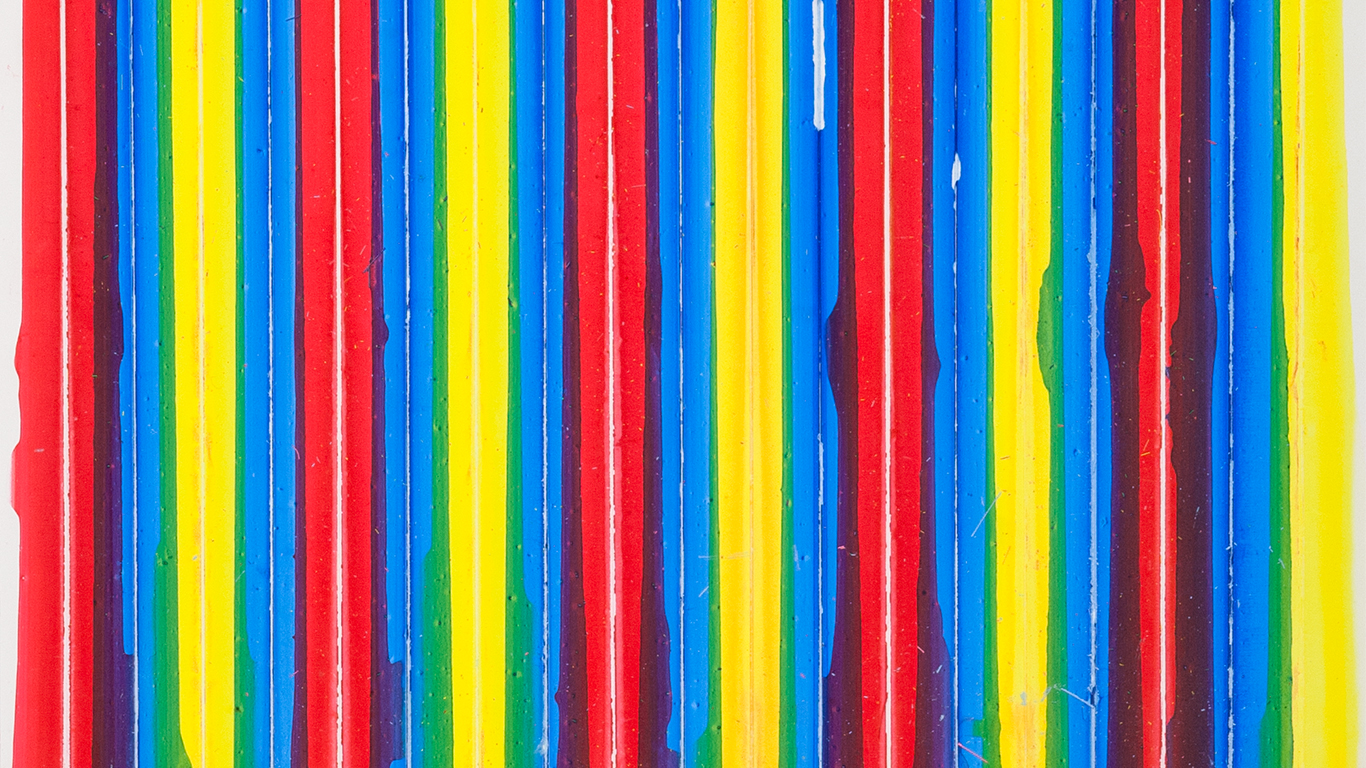
Matt W. Brown, Primary Channels (detail) 2019, acrylic gouache on paper. Courtesy of the artist.
Matt W. Brown began this series of works on paper during a period of profound grief over the loss of a child, Ellis. Contemplative and solitary, the slow process of production involved making folded paper trays to contain diluted pigment and then waiting for weeks to see what evaporation would leave behind on the paper.
As an observer of physical laws governing the materials, Brown soon realized that what had vanished through evaporation was as intrinsic to the work as the visible traces it left behind. Just as a used envelope bears the impression of what it once contained, what is no longer present in the work physically, still exists in the folds of memory and time as evidenced by the accretion of pigments on paper.
According to the artist, “a fold is a weakness, a wound running the length of the paper. A fold is a doubling over; a bend that leaves a scar. It is a condition that forces one thing to become something else. It is an awakening, showing an object in the second dimension that there is perhaps a third.”
The Deleuzian concept of the fold describes the way in which we produce subjectivity through experience. In contrast to conventional notions of a simple interiority/exteriority binary, Deleuze asserts that the inside is nothing more than folding of the outside. Indeed subjectivity comprises an array of folds: of time, memory, our bodies, and our incorporeal being or spirituality.
Struggle in the political and social sphere, or within ourselves, inevitably produces new kinds of subjectivity. For Brown, the process of folding paper and evaporating dilutions provided room for introspection and self-awareness in response to loss. Always interested in process-based outcomes and variations, Brown has used them here to create a liminal space for the production of his own subjectivity in relation to personal tragedy. These works echo the ephemerality of existence while creating a meditative space for the artist to incorporate, or fold into himself, the accumulated contingencies of lived experience.
About the Artist
London artist Matt W. Brown explores incidence, contingency, and liminality through works on paper. He has exhibited in Halifax at the Nova Scotia Archives, Anna Leonowens Gallery, RBC Waterside Centre, Eyelevel Gallery, and the Visual Arts Nova Scotia Corridor Gallery. In London, his work has been featured at Fringe Gallery, Forest City Gallery and Artlab Gallery.
Brown received a Bachelors of Fine Arts from the Nova Scotia College of Art and Design with a major in painting. He is now completing a Masters of Fine Arts degree at the Department of Visual Art, Western University.
September 17 - October 24: Ibghy & Lemmens: Theatre from the Jungle
Theatre from the Jungle
September 17 – October 24, 2020
Richard Ibghy & Marilou Lemmens
With the participation of: Weldemariam Bahta, Mekides Belete, William Lopez Beltran, Tesfagergis Geberezgabier, Miao Yan Huang, Robel Kibrom, Jianwen Kuang, Belaynesh Mekonnen, Juan Mendez, Eduardo Rogriguez, Chen Xuhong, and Yanfang Yang
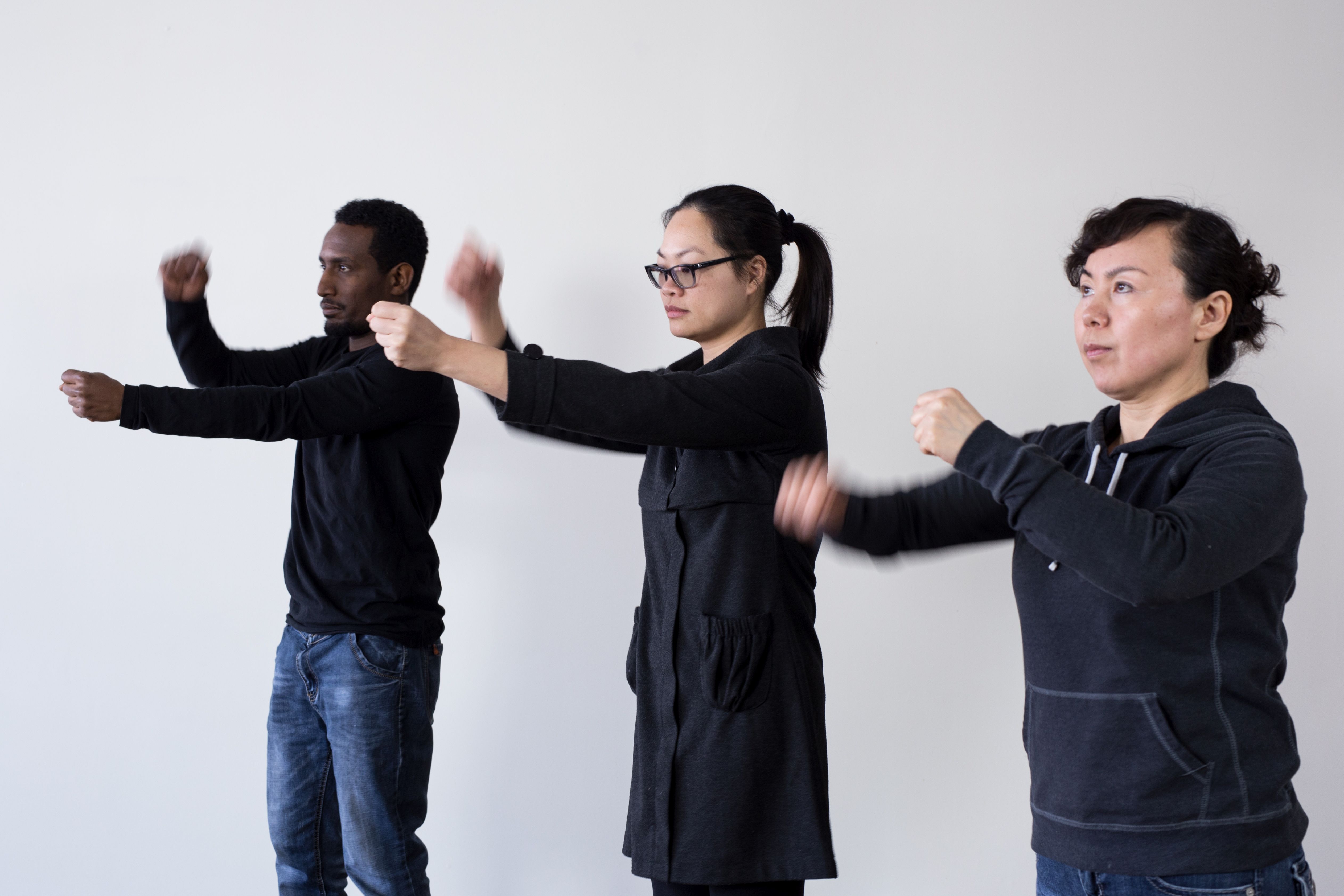
Richard Ibghy & Marilou Lemmens, Meatpacking from Theatre from the Jungle, 2018. HD video (33 minutes). Video Still.
Video Excerpts
Theatre from the Jungle - Meatpacking
Theatre from the Jungle - Reading Group
Theatre from the Jungle - Interview (excerpt) with Elizabeth (Chen)
Theatre from the Jungle - Interview (excerpt) with Tesfegergis
Theatre from the Jungle - Interview (excerpt) with Juan
Many of these immigrant workers arrived in Canada under the Temporary Foreign Worker Program and the Provincial Nominee Program, the latter of which requires immigrants to work at the Maple Leaf factory for two years in exchange for permanent residency. These “Pathway to Permanent Residency” programs, which exist in every Canadian province, expose a vulnerable labour workforce to potential abuse and exploitation. Although Theatre from the Jungle was created in 2018, the issues that Ibghy and Lemmens address are particularly resonant in light of current circumstances. The precarity faced by such workers has become increasingly visible as a result of the COVID-19 pandemic. The culture of meatpacking factories is characterized by working long hours in close proximity. Unlike the many other industries that shut down as a safety measure last March, these plants were deemed an essential part of the food supply chain and stayed open even when social distancing was not possible. Over the past few months, meatpacking plants around the world have become the sites of COVID-19 outbreaks, bringing into sharp relief the risk of physical harm and psychological distress that such work has on vulnerable workers who often have limited other opportunities for employment.
An earlier iteration of this exhibition was shown at the Art Gallery of Southwestern Manitoba (April 12 - June 9, 2018), curated by John G. Hampton.
About the artists:
Based in Durham-Sud, Québec, Richard Ibghy and Marilou Lemmens have developed a collaborative artistic practice that spans across multiple media, including video, performance and installation. Working both sculpturally and with the body, their practice engages the possibility of escaping the productivist logic of modernism and its incarnations in areas of labour, economics, management, psychology, biology, and ethology. Their projects challenge the concept of objectivity and the scientific obsession with measurement by opting for idiosyncratic methodologies in practical experiments, processes of translation, and craft-based data visualisation techniques. These processes allow for contingency, association, and playfulness while also enabling the duo to collaborate with performers, activists, anthropologists, scientists, and communities.
Most recently, their work was presented in solo exhibitions at Bemis Center for Contemporary Arts, Omaha (2019), Musée d’art contemporain de Montréal (2018), Visningsrommet USF Gallery, Bergen, Norway (2018), Audain Gallery, Vancouver (2018), Agnes Etherington Art Centre, Kingston (2017), Jane Lombard Gallery, New York (2017), Owens Art Gallery, Sackville, Canada (2017), International Studio & Curatorial Program, New York (2016), Esker Foundation, Calgary (2016), Leonard & Bina Ellen Art Gallery, Montreal (2016). They have participated in a number of group exhibitions including Fiskars Biennale, Finland (2019), Columbus Museum of Art (2018), OFF-Biennale, Budapest (2017), Bienal de Cuenca, Cuenca, Ecuador (2016), Istanbul Biennial (2015), Herbert Read Gallery, Canterbury (2014), La Biennale de Montréal (2014), La Filature, Scene Nationale and La Kunsthalle, Mulhouse (2013), Henie Onstad Kunstsenter, Høvikodden, Norway (2013), and Sharjah Biennial (2011).
Related Programming:
Panel Discussion
September 24, 2020, 7:00 pm
Featuring Richard Ibghy, Marilou Lemmens, Tony Weiss, moderated by Dr. Helen Gregory
Join us for a panel discussion hosted on Zoom in partnership with the Western University Department of Visual Arts’ Art Now! Speakers Series on Thursday, September 24 at 7:00 pm. Moderated by McIntosh Gallery Curator, Dr. Helen Gregory, Theatre from the Jungle artists Richard Ibghy and Marilou Lemmens and Associate Professor of Geography, Tony Weis will discuss the exhibition presented at McIntosh Gallery as it relates to themes of industrial agriculture and socio-economic, cross-border labour issues.
Webinar recording link: https://www.youtube.com/watch?v=jSCa0O4pr90&t=4s&ab_channel=FacultyofArtsandHumanities
November 5 - December 12: Computational Arts in Canada 1967-1974
Computational Arts in Canada 1967-1974
November 5 – December 12, 2020
Curated by Adam Lauder and Mark Hayward

Suzanne Duquet, PARR IX, 1976, oil and coloured pencil on paper. Collection d’oeuvres d’art l’UQAM, Montreal, Quebec. Image courtesy of the lender.
The first historical survey of Canada’s rich contributions to first-generation computer art, Computational Arts in Canada 1967-1974 assembles an impressive array of animated films, videos, plotter drawings, digital paintings, computer-generated silk-screen prints, and interactive teletype printouts capturing the remarkable diversity of activity during this period of creative ferment and technical innovation. The exhibition shines a light on groundbreaking computer visualizations as well as language-based experiments by Greg Curnoe and the Vancouver-based conceptual enterprise N.E. Thing Co. Ltd. (a.k.a. NETCO). Curnoe’s Computer Journals and the work of experimental filmmaker (and Western University emeritus professor) Alexander Keewatin (“Kee”) Dewdney firmly anchor broader histories in a London, Ontario context by highlighting the interdisciplinary collaborations between artists and researchers facilitated by Western’s Department of Computer Science under the visionary leadership of former chair John Hart. Computational Arts in Canada also illuminates the achievements of women artists in this historically male-dominated field, including Suzanne Duquet—a long-time UQÀM professor of painting who made repeated visits to Western as an artist-in-residence—and the multidisciplinary Web art innovator Vera Frenkel.
Rarely exhibited, foundational computer drawings by former University of Toronto computer science professor Leslie Mezei and French artist Roger Vilder (active in Montréal during the 1960s and 1970s) showcase the formal dazzle, occasional humour and even eroticism that resulted from artists’ earliest experiments in computer graphics. Their work also draws attention to artists’ embeddedness within global networks of research and creative collaboration. This opening onto the world is brought into arresting visibility by Art Ex Machina, a suite of computer-generated silk-screen prints by an international roster of artists, including Frieder Nake and Hiroshi Kawano, published by Montréal artist and gallerist Gilles Gheerbrant in 1972. Based on animations that she programmed during extended summertime stints with Western’s Department of Computer Science in the early 1970s, Duquet’s computer paintings translate machine logics into a highly personal vision. Documents drawn from Duquet’s archive record every step in her creative process—from program to painting—offering rare insights into the materiality of early digital art.
Not limited to works generated by computer, Computational Arts in Canada features artists who engaged with computation in an expanded sense. Although predating his tenure with Western’s Department of Computer Science, Dewdney’s The Maltese Cross Movement (1967) narrates the technics of machine visualization. Frenkel’s pioneering series of teleconferencing performances, String Games: Improvisations for Inter-City Video (1974), straddles materiality and metaphor in enacting a computational frame, one that clears a path for our contemporary world of social media and planetary connectivity.
The exhibition is accompanied by a visually stunning catalogue that includes original scholarly essays by the guest curators—based, in part, on materials held by Western’s archives and collections—as well as a new text by ACAD professor Ashley Scarlett.
Related Programming:
Curator Talk
November 12, 2020, 7:00 pm EST
Featuring Adam Lauder and Mark Hayward
Join us for a lecture hosted on Zoom in partnership with the Western University Department of Visual Arts’ Art Now! Speakers Series on Thursday, November 12 at 7:00 pm EST as exhibition curators Adam Lauder and Mark Hayward will discuss their collaborative project Computational Arts in Canada 1967-1974.
Watch Zoom Webinar recording here.
Contemporary art, visual culture, and art history have long played an important role in facilitating constructive social, political, and diverse cultural conversations.
As such, McIntosh Gallery stands by its responsibility to support the artistic freedom of all exhibiting artists by providing a safe and respectful space for them to express themselves and showcase their work and research. The works in these exhibition express the views of their creators and do not reflect the position of McIntosh Gallery or Western University.


